
Cedarhurst (516) 374-3668
Franklin Square (516) 775-8440

Cedarhurst (516) 374-3668
Franklin Square (516) 775-8440
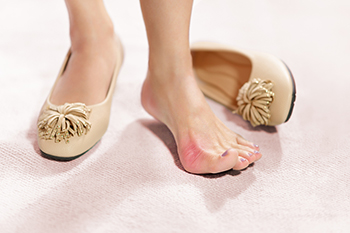
A bunion, hallux valgus, forms when there is a gradual change to the anatomy of the big toe leading to a deformity on the side of the toe that can be painful. This condition worsens when shoes are ill-fitting or have pointed toes that apply pressure to this toe. Dancers, especially ballet dancers (who dance in pointe shoes), are prone to this ailment but anyone can get a bunion. The main symptom of a bunion is a swollen, red area over the deformed joint of the big toe that is tender when touched. One can also experience numbness or a burning sensation if the surrounding nerves become irritated. The big toe angles in and irritation of the skin can lead to blisters or bursitis at the site of the bunion. When severe and long-standing, a bunion may cause the toes to overlap and arthritis, which causes additional pain when walking or performing activities that require one to push off with the feet. To prevent bunions, one can try to change their footwear to shoes that have more room in the toe box and that are wider, modify activities that cause pain, or wear shoe inserts or spacers. It is often recommended that dancers avoid bunion surgery until they stop dancing, as it may interfere with their ability to dance. If you have a bunion that is interfering with your life, consider seeing a podiatrist for proper diagnosis and treatment options.
If you are suffering from bunions, contact Robert Stein, DPM of South Shore Foot Care. Our doctor can provide the care you need to keep you pain-free and on your feet.
What Is a Bunion?
A bunion is formed of swollen tissue or an enlargement of boney growth, usually located at the base joint of the toe that connects to the foot. The swelling occurs due to the bones in the big toe shifting inward, which impacts the other toes of the foot. This causes the area around the base of the big toe to become inflamed and painful.
Why Do Bunions Form?
Genetics – Susceptibility to bunions are often hereditary
Stress on the feet – Poorly fitted and uncomfortable footwear that places stress on feet, such as heels, can worsen existing bunions
How Are Bunions Diagnosed?
Doctors often perform two tests – blood tests and x-rays – when trying to diagnose bunions, especially in the early stages of development. Blood tests help determine if the foot pain is being caused by something else, such as arthritis, while x-rays provide a clear picture of your bone structure to your doctor.
How Are Bunions Treated?
If you have any questions, please feel free to contact our offices located in Cedarhurst and Franklin Square, NY . We offer the newest diagnostic and treatment technologies for all your foot care needs.

Pickleball is one of the most popular sports people are playing now because it is slower and has a lower intensity compared to other sports. However, despite it seeming to be an easier form of exercise, injuries to all parts of the body can still be sustained. Ailments from pickleball related to the feet are commonly associated with the Achilles tendon and ankles. An Achilles strain involves the tendon in the back of the ankle that connects the calf to the heel. This can happen from the sudden stop-and-go actions in pickleball and can be accompanied by a sharp, snapping feeling. Ankle sprains are injuries to the ligaments on the side of the ankle and are typically caused by missteps or faulty landings. Wearing well-fitting and supportive footwear, warming up before playing pickleball, doing stretching and strengthening exercises regularly, and using ankle braces can help. If you get injured during pickleball or get another sports injury, it is important to rest. If pain persists or worsens, see a podiatrist as soon as possible to get a proper diagnosis and treatment plan so you can return to pain-free play.
Ankle and foot injuries are common among athletes and in many sports. They can be caused by several problems and may be potentially serious. If you are feeling pain or think you were injured in a sporting event or when exercising, consult with Robert Stein, DPM from South Shore Foot Care. Our doctor will assess your condition and provide you with quality foot and ankle treatment.
Common Injuries
The most common injuries that occur in sporting activities include:
Symptoms
Symptoms vary depending upon the injury and in some cases, there may be no symptoms at all. However, in most cases, some form of symptom is experienced. Pain, aching, burning, bruising, tenderness, tightness or stiffness, sensation loss, difficulty moving, and swelling are the most common symptoms.
Treatment
Just as symptoms vary depending upon the injury, so do treatment options. A common treatment method is known as the RICE method. This method involves rest, applying ice, compression and elevating the afflicted foot or ankle. If the injury appears to be more serious, surgery might be required, such as arthroscopic or reconstructive surgery. Lastly, rehabilitation or therapy might be needed to gain full functionality in the afflicted area. Any discomfort experienced by an athlete must be evaluated by a licensed, reputable medical professional.
If you have any questions, please feel free to contact our offices located in Cedarhurst and Franklin Square, NY . We offer the newest diagnostic and treatment technologies for all your foot care needs.
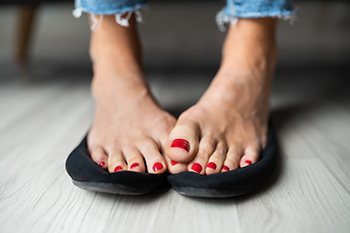
Hyperhidrosis is an ailment that causes people to sweat excessively. It can be embarrassing when it affects the feet, and patients who have plantar hyperhidrosis find the need to change their shoes and socks frequently throughout the day. It can be present from birth, or may start during the teenage years. Additionally, there may be existing medical conditions that can precede the onset of this condition. These include obesity, diabetes, or possibly a thyroid disorder. It can negatively affect a patient's life, and may cause anxiety and their emotional well-being may change. When the feet are constantly wet from sweating, skin rashes or bacterial infections may develop. To obtain a proper diagnosis, many patients undergo a thermoregulatory sweat test. This is done by applying a powder to the feet that is sensitive to moisture. The powder will change color as sweating occurs. If you have this ailment, please speak with a podiatrist who can effectively treat this condition.
If you are suffering from hyperhidrosis contact Robert Stein, DPM of South Shore Foot Care. Our doctor can provide the care you need to attend to all of your foot and ankle needs.
Hyperhidrosis of the Feet
Hyperhidrosis is a rare disorder that can cause people to have excessive sweating of their feet. This can usually occur all on its own without rigorous activity involved. People who suffer from hyperhidrosis may also experience sweaty palms.
Although it is said that sweating is a healthy process meant to cool down the body temperature and to maintain a proper internal temperature, hyperhidrosis may prove to be a huge hindrance on a person’s everyday life.
Plantar hyperhidrosis is considered to be the main form of hyperhidrosis. Secondary hyperhidrosis can refer to sweating that occurs in areas other than the feet or hands and armpits. Often this may be a sign of it being related to another medical condition such as menopause, hyperthyroidism and even Parkinson’s disease.
In order to alleviate this condition, it is important to see your doctor so that they may prescribe the necessary medications so that you can begin to live a normal life again. If this is left untreated, it is said that it will persist throughout an individual’s life.
A last resort approach would be surgery, but it is best to speak with your doctor to find out what may be the best treatment for you.
If you have any questions please feel free to contact our offices located in Cedarhurst and Franklin Square, NY . We offer the newest diagnostic and treatment technologies for all your foot and ankle needs.
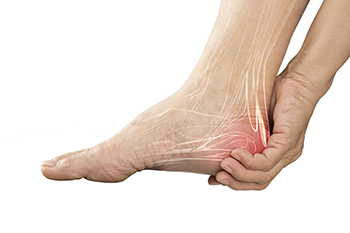
If you are experiencing heel pain, chances are you may have plantar fasciitis, which is the most common cause. Plantar fasciitis occurs when there is an inflammation of the plantar fascia tissue on the bottom of the foot. This connective tissue attaches at the heel bone, then extends towards the forefoot, fanning out into five bands that attach to each toe’s phalanx bone. The plantar fascia supports the arch and helps to act as a shock absorber when walking, running, and jumping. Since the plantar fascia is used continuously in everyday activities it can become stressed, overused, and even torn. The heel pain of plantar fasciitis is usually at its most severe when you take your first steps after waking up or resting. It is suggested that you make an appointment with a podiatrist if you are experiencing any kind of heel pain. Podiatrists treat plantar fasciitis and other forms of heel pain every day and have many therapies and methods of treatment that will offer you the relief you seek.
Plantar fasciitis can be very painful and inconvenient. If you are experiencing heel pain or symptoms of plantar fasciitis, contact Robert Stein, DPM from South Shore Foot Care. Our doctor can provide the care you need to keep you pain-free and on your feet.
What Is Plantar Fasciitis?
Plantar fasciitis is the inflammation of the thick band of tissue that runs along the bottom of your foot, known as the plantar fascia, and causes mild to severe heel pain.
What Causes Plantar Fasciitis?
How Can It Be Treated?
While very treatable, plantar fasciitis is definitely not something that should be ignored. Especially in severe cases, speaking to your doctor right away is highly recommended to avoid complications and severe heel pain. Your podiatrist can work with you to provide the appropriate treatment options tailored to your condition.
If you have any questions please feel free to contact our offices located in Cedarhurst and Franklin Square, NY . We offer the newest diagnostic and treatment technologies for all your foot and ankle needs.
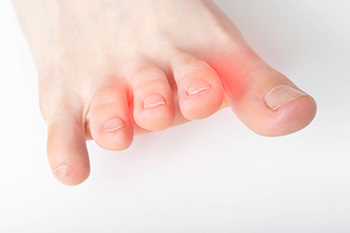
If you walk around feeling like you have a pebble in your shoe under the ball of the foot, you might have Morton’s neuroma. This is a thickening of the tissues next to nerves leading to the toe. Women are much more likely to suffer from this condition than men because they are more apt to wear high heels, which put pressure on the feet. Wearing shoes that are too tight or narrow may also lead to this uncomfortable foot ailment. Beyond feeling like there is a pebble under your foot, one can experience pain, burning, cramping, and/or numbness of the foot. Rest, foot stretching exercises to promote blood circulation, massaging the affected part of the foot, using shoe pads or orthotics to help absorb pressure, and wearing well fitting, flatter, supportive shoes should all help with irritation of a Morton’s neuroma. However, if you are having troubling symptoms for a prolonged time, it is suggested that you contact a podiatrist for proper diagnosis and a treatment plan.
Morton’s neuroma is a very uncomfortable condition to live with. If you think you have Morton’s neuroma, contact Robert Stein, DPM of South Shore Foot Care. Our doctor will attend to all of your foot care needs and answer any of your related questions.
Morton’s Neuroma
Morton's neuroma is a painful foot condition that commonly affects the areas between the second and third or third and fourth toe, although other areas of the foot are also susceptible. Morton’s neuroma is caused by an inflamed nerve in the foot that is being squeezed and aggravated by surrounding bones.
What Increases the Chances of Having Morton’s Neuroma?
Morton’s neuroma is a very treatable condition. Orthotics and shoe inserts can often be used to alleviate the pain on the forefront of the feet. In more severe cases, corticosteroids can also be prescribed. In order to figure out the best treatment for your neuroma, it’s recommended to seek the care of a podiatrist who can diagnose your condition and provide different treatment options.
If you have any questions, please feel free to contact our offices located in Cedarhurst and Franklin Square, NY . We offer the newest diagnostic and treatment technologies for all your foot care needs.

Foot health is important for everyone but because children’s feet are soft, pliable, and still developing, they are more vulnerable to injuries, diseases, and conditions that can interfere with normal movement. More common foot problems among children are Sever’s disease, flat feet, toes pointing in or out, ankle weakness, and foot deformities. Sever’s disease is heel pain in children that may come on during puberty or when experiencing growth spurts. This is usually a temporary affliction and can be managed by stopping sports or activities involving running or jumping until the pain subsides. Flat foot is when the entire sole of the child’s foot lies flat against the ground. If a child walks with their toes pointed in or out it may be because a child’s leg alignment is constantly changing and again may improve as the child grows and muscles get stronger. Children’s ankles may be weak and give way more easily during sports and everyday activities leading to chronic ankle instability. Children may even suffer from congenital foot deformities. It is important to consult with a podiatrist for help in learning and understanding the growth of children’s feet, proper footwear choices as they age, and to treat any foot problems that may arise and are not transitory.
Making sure that your children maintain good foot health is very important as they grow. If you have any questions, contact Robert Stein, DPM of South Shore Foot Care. Our doctor can provide the care you need to keep you pain-free and on your feet.
Keeping Children's Feet Healthy
Having healthy feet during childhood can help prevent medical problems later in life, namely in the back and legs. As children grow, their feet require different types of care. Here are some things to consider...
Although babies do not walk yet, it is still very important to take care of their feet.
Avoid putting tight shoes or socks on his or her feet.
Allow the baby to stretch and kick his or her feet to feel comfortable.
As a toddler, kids are now on the move and begin to develop differently. At this age, toddlers are getting a feel for walking, so don’t be alarmed if your toddler is unsteady or ‘walks funny’.
As your child gets older, it is important to teach them how to take care of their feet.
Show them proper hygiene to prevent infections such as fungus.
Be watchful for any pain or injury.
Have all injuries checked by a doctor as soon as possible.
Comfortable, protective shoes should always be worn, especially at play.
If you have any questions please feel free to contact our offices located in Cedarhurst and Franklin Square, NY . We offer the newest diagnostic and treatment technologies for all your foot and ankle needs.
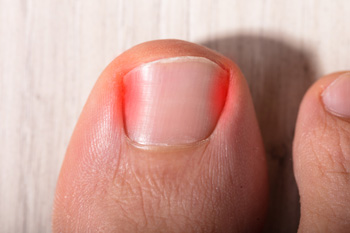
Having an ingrown toenail is annoying and painful, but it can be preventable. When the side of a toenail becomes engulfed by the skin around it, pressure can build up and cause pain. Typical signs of an ingrown toenail include redness and swelling, pain when touched, or hardened skin next to the nail. If the area gets infected, it may become filled with pus and cause bleeding. Causes of ingrown toenails include tight fitting shoes, toenails cut incorrectly or not at all, and poor foot hygiene. Home prevention techniques include cutting toenails straight across, keeping your feet clean and dried, and wearing shoes that fit properly. Anyone who has diabetes, poor peripheral circulation, or other systemic conditions that affect the feet should seek the care of a podiatrist regularly. In cases of a badly ingrown toenail, it is strongly suggested that you consult a podiatrist. Possible treatment may call for partial or complete removal of the nail to prevent further complications.
Ingrown toenails may initially present themselves as a minor discomfort, but they may progress into an infection in the skin without proper treatment. For more information about ingrown toenails, contact Robert Stein, DPM of South Shore Foot Care. Our doctor can provide the care you need to keep you pain-free and on your feet.
Ingrown Toenails
Ingrown toenails are caused when the corner or side of a toenail grows into the soft flesh surrounding it. They often result in redness, swelling, pain, and in some cases, infection. This condition typically affects the big toe and may recur if it is not treated properly.
Causes
You are more likely to develop an ingrown toenail if you are obese, have diabetes, arthritis, or have any fungal infection in your nails. Additionally, people who have foot or toe deformities are at a higher risk of developing an ingrown toenail.
Symptoms
Some symptoms of ingrown toenails are redness, swelling, and pain. In rare cases, there may be a yellowish drainage coming from the nail.
Treatment
Ignoring an ingrown toenail can have serious complications. Infections of the nail border can progress to a deeper soft-tissue infection, which can then turn into a bone infection. You should always speak with your podiatrist if you suspect you have an ingrown toenail, especially if you have diabetes or poor circulation.
If you have any questions, please feel free to contact our offices located in Cedarhurst and Franklin Square, NY . We offer the newest diagnostic and treatment technologies for all your foot care needs.

The bones in the ankle that are prone to breaking are the tibia, fibula, and talus. The tibia and fibula can be felt on the outside of the ankle, while the talus is deep within the ankle. If significant pressure is applied to these bones from occurrences such as a car accident, falling or tripping, the impact of heavy weight, overuse, or a misstep, can all result in a break. A broken ankle can lead to loss of blood supply, damage to neighboring tissues, improper healing, and sharp pieces of bone from the break compressing or severing nearby nerves or blood vessels. It is important to see a podiatrist if you have broken your ankle in order to obtain proper treatment and to prevent more serious complications from arising.
Broken ankles need immediate treatment. If you are seeking treatment, contact Robert Stein, DPM from South Shore Foot Care. Our doctor can provide the care you need to keep you pain-free and on your feet.
Broken Ankles
A broken ankle is experienced when a person fractures their tibia or fibula in the lower leg and ankle area. Both of these bones are attached at the bottom of the leg and combine to form what we know to be our ankle.
When a physician is referring to a break of the ankle, he or she is usually referring to a break in the area where the tibia and fibula are joined to create our ankle joint. Ankles are more prone to fractures because the ankle is an area that suffers a lot of pressure and stress. There are some obvious signs when a person experiences a fractured ankle, and the following symptoms may be present.
Symptoms of a Fractured Ankle
If you suspect an ankle fracture, it is recommended to seek treatment as soon as possible. The sooner you have your podiatrist diagnose the fracture, the quicker you’ll be on the way towards recovery.
If you have any questions, please feel free to contact our offices located in Cedarhurst and Franklin Square, NY . We offer the newest diagnostic and treatment technologies for all your foot care needs.
Every patient is unique and so are treatments. The information on this website is for educational purposes and each individual
patient care model may differ.